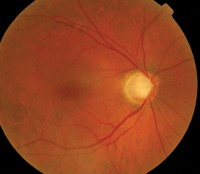 Q: An optometric colleague of mine asked me to check his eyes. He is a 58-year-old white male in good health with vision correctable to 20/20. He had screened himself with a non-mydriatic camera and said his optic discs “looked fine,” but he noticed that the inferior nasal field of the right eye was “obscured.” So, I was not surprised to measure Goldmann pressures of 32mm Hg O.D. and 23mm Hg O.S. Also, a dilated fundus exam revealed 0.75 cupping with a superior notch in the right eye. Should I refer him to a glaucoma specialist or treat him myself?
Q: An optometric colleague of mine asked me to check his eyes. He is a 58-year-old white male in good health with vision correctable to 20/20. He had screened himself with a non-mydriatic camera and said his optic discs “looked fine,” but he noticed that the inferior nasal field of the right eye was “obscured.” So, I was not surprised to measure Goldmann pressures of 32mm Hg O.D. and 23mm Hg O.S. Also, a dilated fundus exam revealed 0.75 cupping with a superior notch in the right eye. Should I refer him to a glaucoma specialist or treat him myself?
A: Well, at the very least, don’t let him treat himself any longer! Unfortunately, this is all too common—more than one-third of optometrists haven’t had a comprehensive eye exam in three years or more, according to Review’s recent Diagnostic Technology Survey. It might be that, because we are eye doctors, we think that nothing will ever happen to our own eyes. We know that we can always get them checked or at least screened by staff members, but we never actually get around to doing so.
At Omni, we offer our referring doctors an annual holiday eye exam, and the response has been tremendous. But it’s important for every O.D. to connect with a local colleague and “swap” eye exams on an annual basis. You’ll have a chance to visit another office, and get to know a friend or a friendly competitor better in the process––not to mention the opportunity to rule out glaucoma, retinal problems or systemic health issues.
All patients—including optometrists—must be dilated to get a stereoscopic look at the optic nerve head. (See “Don’t Skip Dilation,” below.) All patients should have a confrontation visual field and pupil testing. All patients should be asked about a family history of glaucoma.

Could this be your optic nerve? Maybe it’s time to get yours examined.
Now, should you treat this patient or refer him? Of course you should treat this patient! Obtain a visual field and some type of nerve imaging, start the patient on a prostaglandin to bring those pressures down, and see him for follow-up soon.
Glaucoma should be managed by optometrists more often than it is. Why? Because we are trained to do it and we are good at it. Pay attention to detail, the proper diagnostic testing, and careful chart documentation and follow-up.
In this case, our colleague presented with classic open-angle glaucoma that would have gone undetected, with terrible consequences. Instead, it can be controlled, and he can continue to practice happily ever after.
Don’t Skip Dilation
When it comes to dilation, optometrists
offer patients too many choices, in my opinion. For example, some
practices let patients check a box that they “do or do not” prefer to be
dilated. Even when the patient checks “do dilate,” some practices
ignore it and do an undilated exam. By doing this, we’re sending a
message to patients that dilation is bad.
We’ve also become too reliant on screening
devices that “replace dilation,” and are offered as an a la carte menu
from which patients choose. When was the last time you went into your
internist’s office and they asked you, “Would you like to have your
blood pressure checked today?”
Nothing replaces dilation; it’s really
the only way to get a clear view of the peripheral retina and, just as
important (if not more), a stereoscopic view of the optic nerve.

